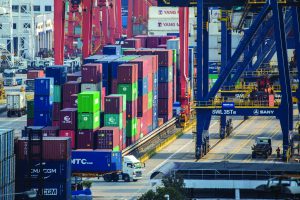BLOOMBERG
Hong Kong’s exports in August posted their longest streak of monthly declines on record, as weak demand and China’s slow recovery continue to pose challenges for the financial hub’s economic growth. Overseas shipments fell 3.7% from a year earlier to HK$358.3 billion ($45.8 billion), the Census and Statistics Department said. That was better than the median estimate of a 6.1% drop in a Bloomberg survey of economists.
It marked a 16th consecutive month of declines — longer than streaks recorded during the Chinese stock market crash in 2015-2016 and the aftermath of the Asian financial crisis in the late 1990s. Imports decreased 0.3% from a year ago, compared with economists’ expectation of a 4.5% dip. The trade deficit was HK$25.6 billion ($3.27 billion). Exports to Asia for the month declined by 3.7% from August 2022, the government spokesperson said in a statement accompanying the data. Shipments to mainland China fell by 1.5%, while those to Japan, Korea, Malaysia and the Philippines dropped by double digits. Exports to the US and EU also shrank. “Weak external demand for goods will continue to weigh on Hong Kong’s export performance in the near term,” according to a government spokesperson in a statement accompanying the data. The decline reflects weak demand from China and has little to do with Hong Kong’s small manufacturing sector. The city acts mainly as a conduit for goods between China and the rest of the world.
“The streak of declines shows Hong Kong’s external trade sector continues to face challenges,” said Gary Ng, senior economist at Natixis. That situation should improve as the destocking cycle of electronics slowly ends, he added.
Warehouses globally stockpiled goods to mitigate the risks that Covid had caused to supply chains. That overstocked supply is now gradually being used up.
The city’s exports have struggled over the past year amid waning demand from China and the rest of the world, challenging the Asian financial hub’s post-pandemic economic recovery.
Authorities earlier this month launched a glitzy campaign to spur domestic consumption and attract tourists in a bid to revive its faltering economy.
Last month, officials narrowed their growth forecast for the year to a range of 4% to 5%. That came after gross domestic product in the April-to-June period grew 1.5% from a year prior, much weaker than economists predicted.
 The Gulf Time Newspaper One of the finest business newspapers in the UAE brought to you by our professional writers and editors.
The Gulf Time Newspaper One of the finest business newspapers in the UAE brought to you by our professional writers and editors.
